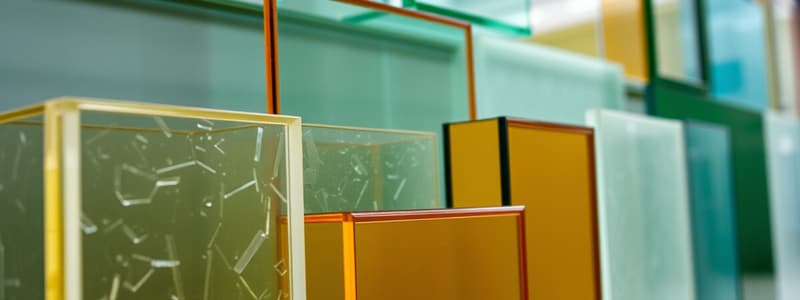Podcast
Questions and Answers
What is a primary use of tempered glass?
What is a primary use of tempered glass?
- Inclusion in decorative art pieces
- Common for non-structural applications
- Used for enhancing energy efficiency in buildings
- Used in shower doors and side vehicle windows (correct)
Which type of glass is known for providing safety and sound insulation?
Which type of glass is known for providing safety and sound insulation?
- Float Glass
- Laminated Glass (correct)
- Tempered Glass
- Frosted Glass
What characterizes low-E glass?
What characterizes low-E glass?
- It is heat-treated for increased durability
- It is primarily used for decorative purposes
- It has a frosted finish for privacy
- It reflects heat while allowing visible light (correct)
Which type of glass is created through a process of sandblasting or acid etching?
Which type of glass is created through a process of sandblasting or acid etching?
In which application is borosilicate glass commonly used?
In which application is borosilicate glass commonly used?
What distinguishes smart glass from other types of glass?
What distinguishes smart glass from other types of glass?
What is a characteristic feature of mirror glass?
What is a characteristic feature of mirror glass?
Which type of glass is known to break into small, blunt pieces rather than sharp shards?
Which type of glass is known to break into small, blunt pieces rather than sharp shards?
Flashcards are hidden until you start studying
Study Notes
Types of Glass
-
Float Glass
- Made by floating molten glass on top of molten tin.
- Results in a smooth, even surface.
- Commonly used in windows and glass doors.
-
Tempered Glass
- Heat-treated to increase strength.
- Breaks into small, blunt pieces rather than sharp shards.
- Used in shower doors, glass doors, and side windows in vehicles.
-
Laminated Glass
- Composed of two or more layers of glass with an interlayer.
- Provides safety and sound insulation.
- Often used in windshields and skylights.
-
Annealed Glass
- Made from regular glass that is slowly cooled to relieve internal stresses.
- Less expensive but more prone to breakage.
- Commonly used in non-structural applications.
-
Low-E Glass (Low Emissivity Glass)
- Coated with a thin layer of metallic oxides.
- Reflects infrared light while allowing visible light to pass.
- Enhances energy efficiency in buildings.
-
Frosted Glass
- Created by sandblasting or acid etching to create a translucent finish.
- Provides privacy while allowing light transmission.
- Used in bathroom windows and office partitions.
-
Borosilicate Glass
- Made from silica and boron trioxide.
- Resistant to thermal shock and chemical corrosion.
- Commonly used in laboratory glassware and cookware.
-
Colored Glass
- Glass that has been colored through additives during production.
- Used for decorative purposes and artistic applications.
- Includes stained glass used in windows and art pieces.
-
Mirror Glass
- Reflective coating applied to one side of glass.
- Used in mirrors and reflective surfaces.
- Can be silvered or coated with other materials.
-
Smart Glass
- Changes transparency in response to electrical signals or light.
- Used in modern architecture and automotive applications.
- Provides privacy and energy efficiency.
-
Glass Ceramics
- Combines the properties of glass and ceramics.
- Used in cooktops and dental applications.
- Highly durable and resistant to thermal shock.
Types of Glass
-
Float Glass
- Produced by floating molten glass on molten tin, resulting in a uniform surface.
- Primarily utilized in windows and glass doors due to its smooth finish.
-
Tempered Glass
- Undergoes heat treatment to enhance strength and durability.
- Breaks into small, blunt pieces, reducing injury risk; commonly used in shower doors and automotive side windows.
-
Laminated Glass
- Constructed from layered glass with an interlayer, enhancing safety and sound insulation.
- Frequently found in windshields and skylights to prevent shattering.
-
Annealed Glass
- Regular glass that is slowly cooled to relieve internal stresses.
- More affordable but fragile, often used in non-structural settings.
-
Low-E Glass (Low Emissivity Glass)
- Features a thin layer of metallic oxides that reflects infrared light while permitting visible light.
- Improves energy efficiency in buildings by reducing heat transfer.
-
Frosted Glass
- Achieved through sandblasting or acid etching, offering a translucent appearance.
- Balances privacy and light transmission; commonly seen in bathrooms and office partitions.
-
Borosilicate Glass
- Composed of silica and boron trioxide, granting resistance to thermal shock and chemical damage.
- Widely used in laboratory glassware and heat-resistant cookware.
-
Colored Glass
- Tint added during production, allowing for decorative and artistic uses.
- Includes stained glass, often used in windows and artwork.
-
Mirror Glass
- A reflective coating applied to one side creates mirrors and reflective surfaces.
- Can be made with silvering or other materials to achieve its reflective quality.
-
Smart Glass
- Changes light transmission in response to electrical signals or light conditions.
- Offers innovative applications in modern architecture and vehicles, enhancing privacy and energy efficiency.
-
Glass Ceramics
- Combines characteristics of both glass and ceramics, resulting in high durability.
- Commonly utilized in cooktops and dental applications due to its thermal resistance.
Studying That Suits You
Use AI to generate personalized quizzes and flashcards to suit your learning preferences.




